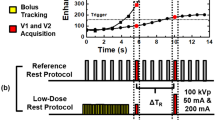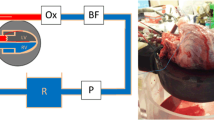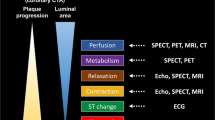Abstract
Background
The accurate assessment of myocardial blood flow (MBF) is a potential adjunct to the anatomy of CT coronary angiography.
Purpose
To compare semi-quantitative parameters from first-pass CT (FP CT) imaging with absolute measures of MBF in an animal model of altered MBF.
Methods
A pig model of intracoronary adenosine (n = 8) was used during FP CT. This produces a zone with hyperemic MBF and a control zone within a slice. A subset of these animals also underwent LAD occlusion with imaging. Fluorescent microspheres (Mcsp) were injected into the left atrium to determine absolute MBF concurrent with CT imaging. Pigs were placed in a 64-slice (Philips) CT with acquisition performed during IC adenosine and occlusion. A 40% dilution of Iopamidol 370 (1 mL/kg) was injected IV at 5 mL/second. CT acquisition was ECG gated over 40 cardiac phases with the following parameters: 180° axial mode (pitch = 0), field of view = 250 mmsq, 512 × 512 matrix, slice thickness = 2.5 mm × 10 slices, temporal resolution = 330 ms, 120 kV, 495 ma. Mcsp were injected immediately following CT imaging. The heart was sectioned into 2.5 mm slices to match the CT images and segmented. Time attenuation curves (TAC) were generated from CT in intervention and control zones based on Mcsp values. Mcsp coronary flow reserve (CFR) = hyperemic/control MBF, and CT CFR was derived from intervention/control area under curve from baseline corrected TIC.
Results
MBF control = .65 ± .28, MBF adenosine = 2.6 ± .7 mL/min/g (P < .0001). CFR = 4.1 ± 1.1, CT CFR = 4.3 ± 1.4 (P = NS). There was a significant (r = .94, P < .0001) correlation between CFR and CT CFR.
Conclusions
CT first-pass myocardial perfusion imaging is feasible using a simple semi-quantitative analysis which provides reasonable estimates of MBF.





Similar content being viewed by others
References
Mollet NR, Cademartin F, Van Meigham CAG, Runza G, McFadden EP, Baks T, et al. High-resolution spiral computed tomography coronary angiography in patients referred for diagnostic conventional coronary angiography. Circulation 2005;112:2318-23
Miller JM, Rochitte CE, Dewey M, Arbab-Zadeh A, Niinuma H, Gottlieb I, et al. Diagnostic performance of coronary angiography by 64-row CT. N Engl J Med 2008;359:2324-36
Califf RM, Phillips HR III, Hindman MC, Mark DB, Lee KL, Behar VS, et al. Prognostic value of a coronary artery jeopardy score. J Am Coll Cardiol 1985;5(5):1055-63
Min JK, Shaw LJ, Devereux RB, Okin PM, Weinsaft JW, Russo DJ, et al. Prognostic value of multidetector coronary computed tomographic angiography for prediction of all-cause mortality. J Am Coll Cardiol 2007;50:1161-70
Gaemperil O, Valenta I, Schepis T, Husmann L, Scheffel H, Desbiolles L, et al. Coronary 64-slice CT angiography predicts outcome in patients with known or suspected coronary artery disease. Eur Radiol 2008;18:1162-73
Van Lingen R, Kakani N, Veitch A, Manghat NE, Roobottom CA, Morgan-Hughes JG. Prognostic and accuracy data of multidetector CT coronary angiography in an established clinical service. Clin Radiol 2009;64:601-7
Gopal A, Nasir K, Ahmadi N, Gul K, Tiano J, Flores M, et al. Cardiac computed tomographic angiography in an outpatient setting: An analysis of clinical outcomes over a 40-month period. J Cardiovasc Comput Tomogr 2009;3:90-5
Shaw LJ, Berman DS, Hendel RC, Borges-Neto S, Min JK, Callister TQ. Prognosis by coronary computed tomographic angiography: Matched comparison with myocardial perfusion single-photon emission computed tomography. J Cardiovasc Comput Tomogr 2008;2:102-4
Schwitter J, Nanz D, Kneifel S, et al. Assessment of myocardial perfusion in coronary artery disease by magnetic resonance: A comparison with positron emission tomography and coronary angiography. Circulation 2001;103:2230-5
Al-Saadi N, Nagel E, Gross M, et al. Noninvasive detection of myocardial ischemia from perfusion reserve based on cardiovascular magnetic resonance. Circulation 2000;101:1379-83
Jahnke C, Nagel E, Gebker R, Kokocinski T, Kelle S, Manka R, et al. Prognostic value of cardiac magnetic resonance stress tests: Adenosine stress perfusion and dobutamine stress wall motion imaging. Circulation 2007;115:1769-76
Klocke FJ, Simonetti OP, Judd RM, et al. Limits of detection of regional differences in vasodilated flow in viable myocardium by first-pass magnetic resonance perfusion imaging. Circulation 2001;104:2412-6
Christian TF, Rettmann D, Aletetras AH, Liao S, Taylor JL, Balaban RS, et al. Absolute myocardial perfusion in canines measured by using dual-bolus first-pass MR imaging. Radiology 2004;232:677-84
Jerosch-Herold M, Wilke N, Wang Y, et al. Direct comparison of an intravascular and an extracellular contrast agent for quantification of myocardial perfusion: Cardiac MRI Group. Int J Card Imaging 1999;15:453-64
George RT, Jerosch-Herold M, Silva C, Kitagawa K, Bluemke DA, Lima JA, et al. Quantification of myocardial perfusion using dynamic 64-detector computed tomography. Invest Radiol 2007;42:815-22
Groves AM, Goh V, Rajasekharan S, Kayani I, Endozo R, Dickson JC, et al. CT coronary angiography: Quantitative assessment of myocardial perfusion using test bolus data-initial experience. Eur Radiol 2008;18:2155-63
Rumberger JA, Bell MR. Measurement of myocardial perfusion and cardiac output using intravenous injection methods by ultrafast (cine) computed tomography. Invest Radiol 1992;27:S40-6
Borges-Neto S, Shaw LK, Tuttle RH, Alexander JH, Smith IV WT, Chambless M, et al. Incremental prognostic power of single-photon emission computed tomographic myocardial perfusion imaging in patients with known or suspected coronary artery disease. Am J Cardiol 2005;95:182-8
Marie PY, Danchin N, Durand JF, Feldmann L, Grentzinger A, Olivier P, et al. Long-term prediction of major ischemic events by exercise thallium-201 single-photon emission computed tomography. Incremental prognostic value compared with clinical, exercise testing, catheterization and radionuclide angiographic data. J Am Coll Cardiol 1995;26:879-86
Pollock SG, Abbott RD, Boucher CA, Beller GA, Kaul S. Independent and incremental prognostic value of tests performed in hierarchical order to evaluate patients with suspected coronary artery disease. Validation of models based on these tests. Circulation 1992;85:237-48
Ciaroni S, Bloch A, Hoffman JL, Bettoni M, Fournet D. Prognostic value of dobutamine echocardiography in patients with intermediate coronary lesions at angiography. Echocardiography 2002;19:549-53
Rizzello V, Poldermans D, Schinkel AF, Biagini E, Boersma E, Elhendy A, Sozzi FB, Maat A, Crea F, Roelandt JR, Bax JJ. Long-term prognostic value of myocardial viability and ischemia during dobutamine stress echocardiography in patients with ischemic cardiomyopathy undergoing coronary revascularization. Heart 2006;92:239-44
Javadi M, Mahesh M, McBride G, Voicu C, Epley W, Merrill J, et al. Lowering radiation dose for integrated assessment of coronary morphology and physiology: First experience with step-and-shoot CT angiography in a rubidium 82 PET-CT protocol. J Nucl Cardiol 2008;15:783-90
Verani MS, Mahmarian JJ, Hixson JB, Boyce TM, Staudacher RA. Diagnosis of coronary artery disease by controlled coronary vasodilation with adenosine and thallium-201 scintigraphy in patients unable to exercise. Circulation 1990;82:80-7
Author information
Authors and Affiliations
Corresponding author
Additional information
See related editorial on doi:10.1007/s12350-010-9250-2.
Rights and permissions
About this article
Cite this article
Christian, T.F., Frankish, M.L., Sisemoore, J.H. et al. Myocardial perfusion imaging with first-pass computed tomographic imaging: Measurement of coronary flow reserve in an animal model of regional hyperemia. J. Nucl. Cardiol. 17, 625–630 (2010). https://doi.org/10.1007/s12350-010-9206-6
Received:
Accepted:
Published:
Issue Date:
DOI: https://doi.org/10.1007/s12350-010-9206-6




